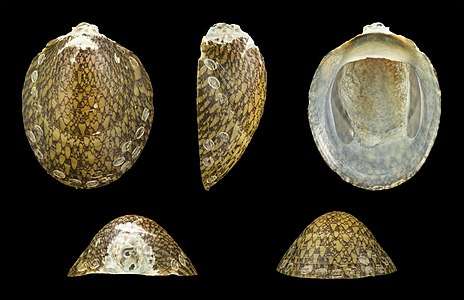Septaria (gastropod)
Septaria is a genus of freshwater and brackish water snails, gastropod mollusks in the family Neritidae.[1][2] These superficially limpet-like snails are native to the Indo-Pacific region.[3] Most species are found in rivers and streams, mainly fast-flowing, but two (S. livida and S. tesselata; sometimes in their own subgenus Navicella) live in brackish coastal waters and the lower tidal section of rivers and streams.[3] Their eggs are attached to hard surfaces such as stones. After hatching, many veligers avoid being swept away by the current by swimming close to the bottom, but it is speculated that some flow downstream into the sea only to return to freshwater later.[3] The shell length of these snails is up to 3.3 cm (1.3 in), but there are some size variations depending on exact species.[3]
| Septaria | |
|---|---|
_-_Septaridae_-_Mollusc_shell.jpeg) | |
| Septaria porcellana shells | |
| Scientific classification | |
| Kingdom: | |
| Phylum: | |
| Class: | |
| (unranked): | |
| Superfamily: | |
| Family: | |
| Subfamily: | Neritinae |
| Tribe: | Neritinini |
| Genus: | Septaria |
| Type species | |
| Patella borbonica Saint-Vincent, 1803 | |
| Synonyms[1] | |
|
Navicella Lamarck, 1816 | |
Species
Species within the genus Septaria include:
- Septaria apiata (Le Guillou in Récluz, 1841)[3]
- Septaria borbonica (Saint-Vincent, 1803)[4] - type species[5]
- Septaria bougainvillei (Récluz, 1841)[3]
- Septaria cumingiana (Récluz, 1842)[3]
- Septaria janelli (Récluz, 1841)[3]
- Septaria lineata (Lamarck, 1816)[2]
- Septaria livida (Reeve, 1856)[3]
- Septaria luzonica (Souleyet in Récluz, 1842)[3]
- Septaria macrocephala (Le Guillou in Récluz, 1841)[3]
- Septaria porcellana (Linnaeus, 1758)[2]
- Septaria sanguisuga (Reeve, 1856)[3]
- Septaria suffreni (Récluz, 1841)[3]
- Septaria taitana Mousson, 1869[3]
- Septaria tessellata (Lamarck, 1816)[3]
- Septaria luzonica
 Septaria porcellana
Septaria porcellana- Septaria tesselata
Several additional species have been described, but are now considered synonyms.[3] Species brought into synonymy include:
- Septaria suborbicularis (G. B. Sowerby I, 1825): synonym of Septaria porcellana (Linnaeus, 1758)
References
- Septaria . Retrieved through: World Register of Marine Species on 4 May 2010.
- (file created 29 July 2010) FRESH WATER MOLLUSCAN SPECIES IN INDIA. 11 pp. accessed 31 July 2010.
- Haynes A. (2001). "A revision of the genus Septaria FÉRUSSAC, 1803 (Gastropoda: Neritimorpha)". Annalen des Naturhistorischen Museums in Wien 103B: 177-229. PDF.
- Septaria borbonica (Saint-Vincent, 1803). Retrieved through: World Register of Marine Species on 4 May 2010.
- Brown D. S. (1994). Freshwater Snails of Africa and their Medical Importance. Taylor & Francis. ISBN 0-7484-0026-5.